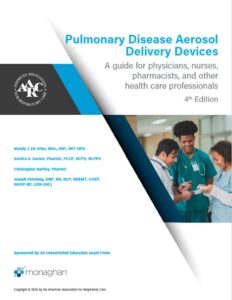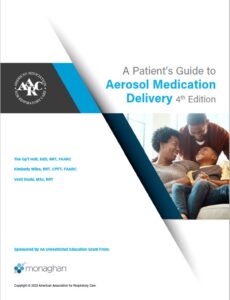
About Aerosol Therapy
Aerosol therapy is considered to be one of the cornerstones in the management and treatment of chronic respiratory disease and exemplifies the nuances of both the art and science of 21st century medicine. As chronic respiratory disease continues to grow in prevalence and consume a large portion of healthcare dollars, an explicit understanding of the science of aerosol therapy, the nuances of the different delivery devices, and the ability to provide accurate and reliable education to patients has become increasingly important.
The American Association for Respiratory Care (AARC) has acknowledged these simplistic but difficult objectives for many years as part of the core scope of clinical practice for respiratory therapists. Several years ago, the strategic decision was made to develop a comprehensive set of aerosol delivery device guidelines to help achieve these objectives with clinicians and patients alike. Now in their updated and revised editions, the AARC is proud to present the following three aerosol guides.

A Guide to Aerosol Delivery Devices for the Respiratory Therapist — 5th Edition
CRCE: 6 hours | Cost: Free for AARC members, $108 for non-members
Aerosol therapy is a cornerstone of respiratory therapy that exemplifies the nuances of both the art and science of 21st century medicine. As respiratory therapists are the only health care providers who receive extensive formal education and who are tested for competency in aerosol therapy, their ability to manage patients with both acute and chronic respiratory disease as the experts in aerosol therapy allows the concept of “art” and “science” to take on a practical reality.
The fifth edition of this Aerosol Guide delivers detailed and comprehensive information that, when combined with your dedication and commitment to be the professional experts in this important area, will empower you to provide guidance to your physician, nurse, and pharmacist colleagues — but, most importantly, to your patients.
Download the Free Guide
Earn CRCE Credit
Supported with an educational grant from:
![]()

Pulmonary Disease Aerosol Delivery Devices; A Guide for Physicians, Nurses, Pharmacists, and Other Health Care Professionals — 4th Edition
This Guide, which is intended for the non-respiratory therapist, will offer pertinent information on aerosol delivery systems now available on the U.S. market. Considerations for selecting the appropriate device for each individual patient, pediatric and neonatal aerosol delivery, patient education, as well as infection control are included. The Guide will also provide application instructions for all supported devices and medications currently available at the time of this publication. There are three most common and fundamental types of delivery systems: nebulizers, pressurized metered dose inhalers, and dry-powder inhalers. Each has unique qualities and delivery capabilities. Good self-management and use of the appropriate device for each patient will significantly increase the likelihood of long-term adherence.
Supported with an educational grant from:
![]()

A Patient’s Guide to Aerosol Medication Delivery — 4th Edition
Gaining as much information as possible about your aerosol delivery devices is essential. You have taken a positive first step by obtaining this fourth edition of “A Patient’s Guide to Aerosol Medication Delivery.” The American Association for Respiratory Care (AARC) asked respiratory therapists who were noted aerosol delivery experts to write this guide. This guide was written with you in mind. As you know, the number of medications and the devices that deliver them change often. That is why it is important for you to understand the critical differences between these devices and, more importantly, how to use your device(s) correctly so that you can maximize the intended result that the medication delivers. We encourage you to become proficient in the use of your aerosol delivery devices and never hesitate to ask questions of your physician or respiratory therapist.
This Patient Guide will provide you with step-by-step education on all available devices on the U.S. market today. Currently, there are five basic types of delivery systems which include nebulizers, metered-dose inhalers, soft-mist inhalers, dry-powder inhalers, and nasal inhalers. All four have their own specific characteristics and delivery capabilities that require your physician to determine which was the most appropriate for you.
Supported with an educational grant from:
![]()





